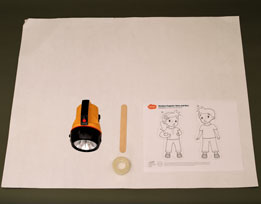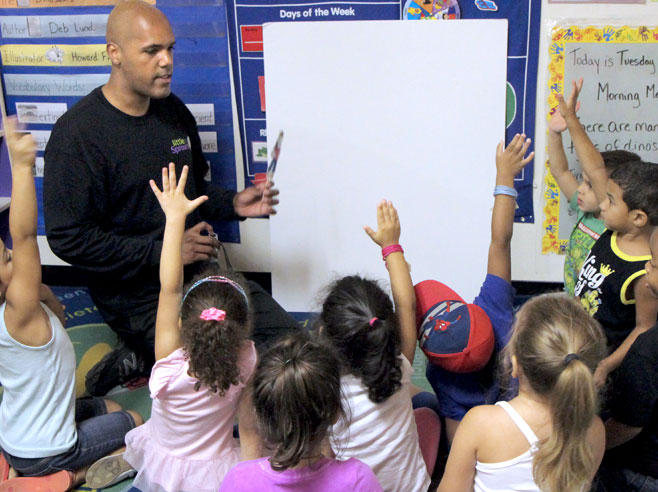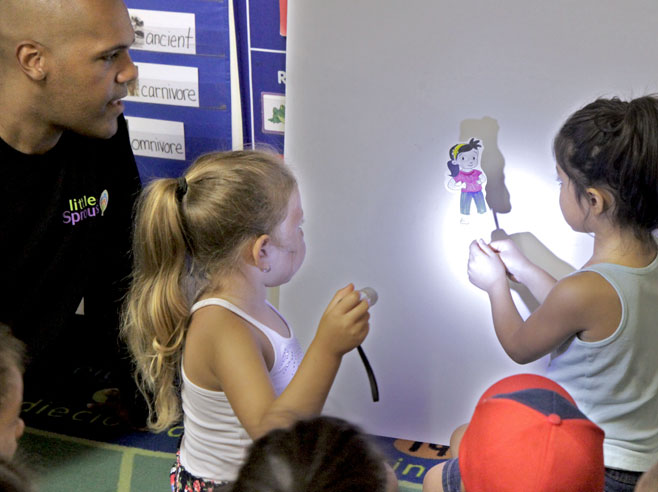Children participate in shadow demonstrations using a flashlight, a hand, and a shadow puppet. What happens to the shadow as the hand or shadow puppet gets closer to the flashlight?
Materials

- Cardstock
- Craft sticks, straws, chopsticks, or similar sticks for the shadow puppets
- Large piece of white cardboard or tri-fold display board to use as “shadow” wall
- Flashlight or desk lamp
- Shadow Puppets (PDF)
- Scissors
- Tape
Preparation
- Make a copy of the Shadow Puppets PDF onto cardstock paper if possible. Color and cut out each shadow puppet and tape it to a craft stick, straw, or chopstick.
- Gather the materials in the Circle Time area.
Directions: Lesson 4
Circle Time: Introduction
- Invite children to sit in a half circle around the “shadow wall” (tri-fold display board or white cardboard leaning against the wall) so everyone will be able to see the shadows. Darken the room as needed.
- Encourage children to think about what they know about shadows. Last week we explored ways we can make shadows. What do we need to make a shadow? (We need a light, something to block the light, and a surface on which the shadow appears.)
- Ask two volunteers to demonstrate how to make a shadow of one of the stick puppets appear on the shadow wall, using the puppet and a flashlight. Provide support as needed. Help children observe where the stick puppet needs to be positioned in order to cast a shadow on the shadow wall: between the flashlight and the shadow wall.
- Tell children that today they are going to compare shadows and explore how to change the size of a shadow—how to make it bigger, and how to make it smaller.
- Do a demonstration with the flashlight as children observe. Hold your hand at a distance from the light, near the wall, where it will cast a small, clear shadow. Ask children to describe what they see. Talk about what makes the shadow. (The light shines on the wall except for where the hand blocks the light; the light can’t shine through the hand so it creates a dark shadow on the surface behind the hand. Your hand only blocks a little light from the flashlight, so the shadow is little.)
- Slowly move your hand closer to the flashlight. How is the shadow changing? (As your hand moves closer to the light, it blocks more and more of the light and the shadow gets bigger.)
- Have a volunteer come up and cast a hand shadow. Hold the flashlight steady in one spot and observe together as the child moves his or her hand farther from or closer to the wall and the shadow gradually grows bigger or smaller in size. Encourage the class to describe how the shadow changes and explain why.
- After several rounds with different volunteers, try a prediction activity. Turn off the flashlight and have a child put her/his hand close to the flashlight or close to the wall (child’s choice). Ask the class to make a prediction: Do you predict that (child’s name) hand will block a lot of light or just a little light? Do you think it will make a big shadow or a small shadow? Why do you think so? Turn on the flashlight and see if their predictions were correct.
- Repeat the same experiment with a child holding a shadow puppet of Nor or Nico. Then turn off the flashlight and ask the class to make a prediction: Where would you put the puppet if you wanted to see a really big shadow? Close to or far away from the flashlight? Why do you think that? Turn on the flashlight to see if their prediction is correct.
Learning Center
- Children can work together to continue exploring making big and small shadows.
- Have one child hold the flashlight and turn it off. Have another child hold the puppet in between the flashlight and the wall. Possible discussion ideas:
- Can you describe the position of the puppet? Is it close to or far away from the light?
- Encourage children to make a prediction. Will the shadow be big or small? Why do you think so?
- Guide children to turn on the light and make observations. Is your shadow big or small? Why do you think the shadow is (big/small)?
- Have partners switch roles and repeat the activity. You may want to ask:
- Can you make a really big shadow? Can you make a really small shadow?


